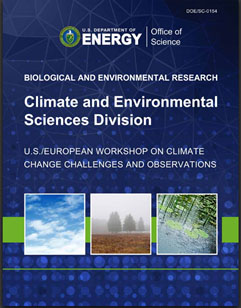Workshop Identifies Critical Climate Science Challenges
Published: 29 November 2012

Clouds and aerosols remain as major sources of uncertainty in computer models of Earth systems. In large part, this uncertainty is due to a lack in understanding of how water (in all its phases) couples to circulations and to the difficulty in coupling the Earth’s surface and atmospheric modules in the models. Key to the coupling issue is providing a better understanding of the physical and biological processes involved in that coupling which in turn requires detailed measurements of these processes.
On November 6–8, scientists from six Department of Energy national laboratories and more than two dozen universities, research institutes, and agencies in the United States and Europe gathered in Washington, DC to identify outstanding climate change science questions related to clouds, aerosols and precipitation, and observational strategies for addressing them. Sponsored by the Department of Energy and several European centers, the group spent two-and-a-half intense days discussing and refining their ideas around six high-level scientific questions:
- What is the distribution of aerosol properties for the Atmospheric Model Intercomparison Project (AMIP) period (e.g., since 1979)?
- What is the coupling among microphysics, aerosols, and cloud dynamics as a function of scale and regime (e.g. vertical velocity or stability)?
- How are precipitation, water vapor, and cloudiness coupled, and what role does organization play in this coupling?
- How do clouds and precipitation couple with surface properties?
- What is the response of clouds to warming?
- What is the response of the Probability Density Function of precipitation to warming?
These questions provided a framework for identifying measurement gaps and priorities. The ensuing discussions generated several common themes where progress could be made in closing these gaps.
The joint workshop was a critical first step in enhancing the collaboration among climate research activities to better serve the international science community. Its findings will be useful for setting priorities within DOE and the participating European centers as well as establishing milestones for future collaborations.
More information about the workshop, including participants, discussions, and recommendations, will be available in a forthcoming workshop report. Meeting moderators also plan to develop and submit to the Bulletin of the American Meteorological Association a separate manuscript that summarizes the workshop findings.
Workshop at a Glance
Keynote speakers from the sponsoring DOE and European climate research programs opened the meeting with four talks to provide context and guidance for the meeting. A series of breakout sessions then followed to brainstorm and catalog science drivers and technical approaches to address aerosol-cloud-precipitation processes. Moderators helped to balance “blue sky” ideas with pragmatic considerations of European and U.S. research foci and practical limitations. The breakout sessions focused on:
- Day 1: key climate change scientific challenges
- Day 2: observations and data products required for addressing these challenges
- Day 3: collaborative efforts between the U.S. and European centers for better addressing the issues identified.
At the end of each day, discussion leaders summarized the discussion from each breakout group in a plenary session. These summaries were then used to begin drafting the workshop report. (Final report published by DOE in December 2012.)
The ARM Climate Research Facility is a DOE Office of Science user facility. The ARM Facility is operated by nine DOE national laboratories, including .
Keep up with the Atmospheric Observer
Updates on ARM news, events, and opportunities delivered to your inbox
ARM User Profile
ARM welcomes users from all institutions and nations. A free ARM user account is needed to access ARM data.


















